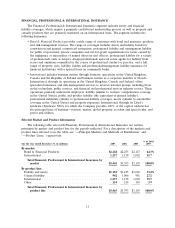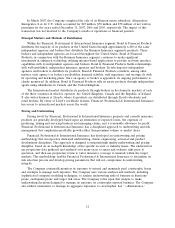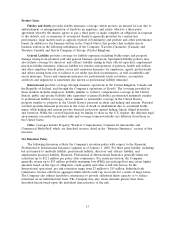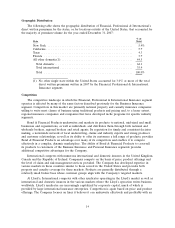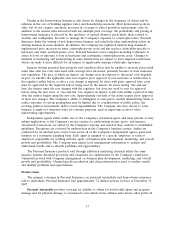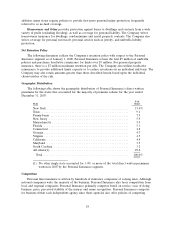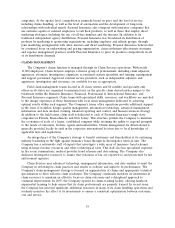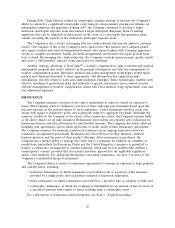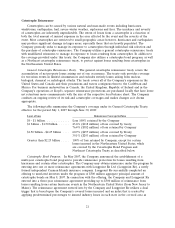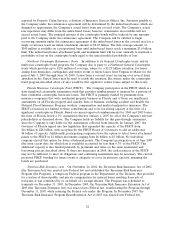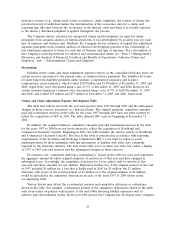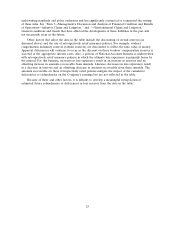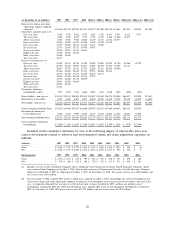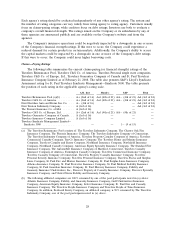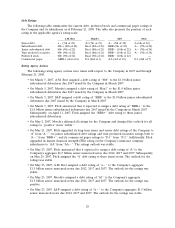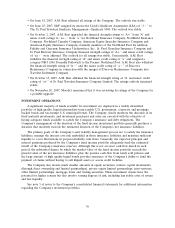Travelers 2007 Annual Report Download - page 33
Download and view the complete annual report
Please find page 33 of the 2007 Travelers annual report below. You can navigate through the pages in the report by either clicking on the pages listed below, or by using the keyword search tool below to find specific information within the annual report.
Catastrophe Reinsurance
Catastrophes can be caused by various natural and man-made events including hurricanes,
windstorms, earthquakes, hail, severe winter weather, explosions and fires. The incidence and severity
of catastrophes are inherently unpredictable. The extent of losses from a catastrophe is a function of
both the total amount of insured exposure in the area affected by the event and the severity of the
event. Most catastrophes are restricted to small geographic areas; however, hurricanes and earthquakes
may produce significant damage in larger areas, especially those that are heavily populated. The
Company generally seeks to manage its exposure to catastrophes through individual risk selection and
the purchase of catastrophe reinsurance. The Company utilizes a general catastrophe reinsurance treaty
with unaffiliated reinsurers to manage its exposure to losses resulting from catastrophes. In addition to
the coverage provided under this treaty, the Company also utilizes a catastrophe bond program, as well
as a Northeast catastrophe reinsurance treaty, to protect against losses resulting from catastrophes in
the Northeastern United States.
General Catastrophe Reinsurance Treaty. The general catastrophe reinsurance treaty covers the
accumulation of net property losses arising out of one occurrence. The treaty only provides coverage
for terrorism events in limited circumstances and excludes entirely losses arising from nuclear,
biological, chemical or radiological attacks. The treaty covers all of the Company’s exposures in the
United States and Canada and their possessions and waters contiguous thereto, the Caribbean and
Mexico. For business underwritten in Canada, the United Kingdom, Republic of Ireland and in the
Company’s operations at Lloyd’s, separate reinsurance protections are purchased locally that have lower
net retentions more commensurate with the size of the respective local balance sheet. The Company
conducts an ongoing review of its risk and catastrophe coverages and makes changes as it deems
appropriate.
The following table summarizes the Company’s coverage under its General Catastrophe Treaty,
effective for the period July 1, 2007 through June 30, 2008:
Layer of Loss Reinsurance Coverage In-Force
$0 - $1 billion .............. Loss 100% retained by the Company
$1 billion - $1.50 billion ...... 23.6% ($118 million) of loss covered by treaty;
76.4% ($382 million) of loss retained by Company
$1.50 billion - $2.25 billion .... 60.9% ($457 million) of loss covered by Treaty;
39.1% ($293 million) of loss retained by Company
Greater than $2.25 billion ..... 100% of loss retained by Company, except for certain
losses incurred in the Northeastern United States, which
are covered by the Catastrophe Bond Program and
Northeast Catastrophe Treaty as described below.
Catastrophe Bond Program. In May 2007, the Company announced the establishment of a
multi-year catastrophe bond program to provide reinsurance protection for losses resulting from
hurricanes and certain other catastrophes. The Company may obtain reinsurance under the program by
entering into one or more reinsurance agreements with Longpoint Re Ltd. (Longpoint Re), a newly
formed independent Cayman Islands insurance company. Longpoint Re successfully completed an
offering to unrelated investors under the program of $500 million aggregate principal amount of
catastrophe bonds on May 8, 2007. In connection with the offering, the Company and Longpoint Re
entered into a three-year reinsurance agreement providing up to $500 million of reinsurance from
losses resulting from certain hurricane events in the Northeastern United States (from New Jersey to
Maine). The reinsurance agreement entered into by the Company and Longpoint Re utilizes a dual
trigger that is based upon the Company’s covered losses incurred and an index that is created by
applying predetermined percentages to insured industry losses in each state in the covered area as
21


